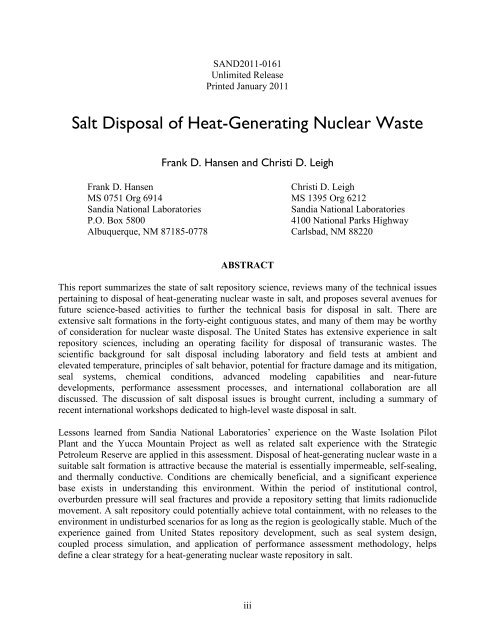Salt Disposal of Heat-Generating Nuclear Waste
Salt Disposal of Heat-Generating Nuclear Waste
Salt Disposal of Heat-Generating Nuclear Waste
You also want an ePaper? Increase the reach of your titles
YUMPU automatically turns print PDFs into web optimized ePapers that Google loves.
SAND2011-0161<br />
Unlimited Release<br />
Printed January 2011<br />
<strong>Salt</strong> <strong>Disposal</strong> <strong>of</strong> <strong>Heat</strong>-<strong>Generating</strong> <strong>Nuclear</strong> <strong>Waste</strong><br />
Frank D. Hansen and Christi D. Leigh<br />
Frank D. Hansen<br />
Christi D. Leigh<br />
MS 0751 Org 6914 MS 1395 Org 6212<br />
Sandia National Laboratories<br />
Sandia National Laboratories<br />
P.O. Box 5800<br />
4100 National Parks Highway<br />
Albuquerque, NM 87185-0778 Carlsbad, NM 88220<br />
ABSTRACT<br />
This report summarizes the state <strong>of</strong> salt repository science, reviews many <strong>of</strong> the technical issues<br />
pertaining to disposal <strong>of</strong> heat-generating nuclear waste in salt, and proposes several avenues for<br />
future science-based activities to further the technical basis for disposal in salt. There are<br />
extensive salt formations in the forty-eight contiguous states, and many <strong>of</strong> them may be worthy<br />
<strong>of</strong> consideration for nuclear waste disposal. The United States has extensive experience in salt<br />
repository sciences, including an operating facility for disposal <strong>of</strong> transuranic wastes. The<br />
scientific background for salt disposal including laboratory and field tests at ambient and<br />
elevated temperature, principles <strong>of</strong> salt behavior, potential for fracture damage and its mitigation,<br />
seal systems, chemical conditions, advanced modeling capabilities and near-future<br />
developments, performance assessment processes, and international collaboration are all<br />
discussed. The discussion <strong>of</strong> salt disposal issues is brought current, including a summary <strong>of</strong><br />
recent international workshops dedicated to high-level waste disposal in salt.<br />
Lessons learned from Sandia National Laboratories’ experience on the <strong>Waste</strong> Isolation Pilot<br />
Plant and the Yucca Mountain Project as well as related salt experience with the Strategic<br />
Petroleum Reserve are applied in this assessment. <strong>Disposal</strong> <strong>of</strong> heat-generating nuclear waste in a<br />
suitable salt formation is attractive because the material is essentially impermeable, self-sealing,<br />
and thermally conductive. Conditions are chemically beneficial, and a significant experience<br />
base exists in understanding this environment. Within the period <strong>of</strong> institutional control,<br />
overburden pressure will seal fractures and provide a repository setting that limits radionuclide<br />
movement. A salt repository could potentially achieve total containment, with no releases to the<br />
environment in undisturbed scenarios for as long as the region is geologically stable. Much <strong>of</strong> the<br />
experience gained from United States repository development, such as seal system design,<br />
coupled process simulation, and application <strong>of</strong> performance assessment methodology, helps<br />
define a clear strategy for a heat-generating nuclear waste repository in salt.<br />
iii
















